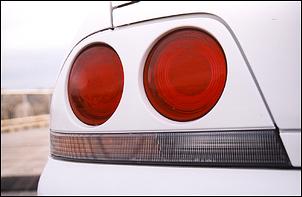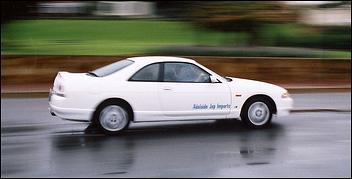Motoring:
Nissan Skyline R33 GTS25T
A large, reasonably practical and entertaining to drive coupe - and what a great engine...

The R33 Skyline GTS25T carried on a long line of high-performance RWD Nissan coupes that were based on a sedan platform. Indeed, the Skyline family tree goes back a long way, but the first model to use the now-legendary RB-series engine was the boxy-styled R31. Australia saw the long-stroke RB30 SOHC engine in the R31 Skyline sedan and wagon, but we were never treated to the Japanese-market DOHC RB20 turbo variant. Note that, except for the limited run of GT-Rs - the R31 sedan and wagon was also the last Skylines to be officially brought to Australia; all we get now are second-hand Japanese imports.
In Japan, the R31 was replaced by the R32. The R32 GTS-t coupe was a significant aesthetic step up over the R31 and it came powered by a more up-spec (158kW) version of the RB20DET engine - a very good all-round vehicle.
After the R32 was discontinued in mid-1993, Nissan Japan kicked off the R33 Skyline series. A little larger overall than the R32, this model took on somewhat of a bland profile - but the coupe version scored fancy headlights, sexy 'stove top' tail lights and an integrated rear spoiler. However, the waistline and bootlid were set quite high, which makes the rear section of the R33 coupe appear a little bulbous.

On the road, the R33 GTS25T coupe's 1360kg kerb mass is apparent. This is - no doubt - one reason why the R32's RB20DET engine was superseded by the half-a-litre-bigger RB25DET. The extra capacity squeezed out of the same RB block involved increasing bore and stroke to 86.0 x 71.7mm (up from 78.0 x 69.7mm respectively). However, the RB25 also features much larger inlet runners than the RB20, a vastly improved cylinder head, a larger (ceramic turbine) turbocharger and a marginally larger air-to-air intercooler. A relatively high 9.0:1 compression ratio maintains good off-boost driveability and an airflow meter is used as the engine load sensor.
Enough gobblygook; the RB25DET is undoubtedly one of the best single turbo engines we've ever sat behind. Off-boost torque is strong, but get some load on above about 3000 rpm and she's a real rocket. Torque holds strong until close to the 7000 rpm redline - though note that our test car had been equipped with an aftermarket exhaust system. A short drive will have you believing every one of those 187kW (at 6400 rpm) and 294Nm (at 4800 rpm).
The RB25 turbo comes with either a 4-speed auto or a 5-speed manual. Our 5-speeder displayed a nice positive throw, though the clutch had been changed to an aftermarket item; this gave the most sudden transition of any clutch we've had the displeasure of operating! Despite this, the RB engine was reluctant to stall when taking off - which points to (among other things) extensive OE computer mapping. Under the rear of the R33 GTS25T you'll find a 4.11 viscous LSD.

The 5-speed R33 GTS25T can certainly lift its skirts and move. With just an average easy-to-repeat kind of launch, the GTS25T powers to 100 km/h in around 6 seconds. Thanks to the Japanese speed limiter, you can't go any quicker than 180 km/h, but it feels like it could easily press on to around 230 kays. Of course, fuel consumption can be pretty horrific when you've got the hammer down - we recorded around 13-litres per 100km on average during our "enthusiastic' test.
The R33 is quite a large car - but its chassis is very well suited to an urban chuck-about. Tromp it a little early exiting a corner the back end squats, cork-screws a little and then eases to the side oh-so progressively. It's so sublime you don't always realise that it's happening. Having said this, we get the feeling that if you kept your boot fully in and 'lost it', the runaway 1360kg would be difficult to reign back... Indeed, the GTS25T handles as you'd expect a 187kW RWDer to - it's a definite power oversteerer.
As the side badges imply, the GTS25T is a very capable Grand Tourer. It sits very securely on its front wishbones/struts and its multi-link strut rear at all speeds. The ride is just about perfect for this type of vehicle - it's slightly firmer than an everyday car, but at times it does suffer a bit of jiggle over small amplitude bumps. HICAS - as far as we know - came as standard fitment to all GTS25Ts, comprising a system that just forces a slight rear toe change during cornering. Swaybars are fitted front and rear.
Standard rolling stock is nothing outrageous - S14 200SX-style 16 x 6.5-inch six spokers, wearing standard 205/55 rubber. Behind these hides a set of brakes that perform perfectly adequately - despite the fact that our test vehicle did not come with the optional ABS. Pedal response was excellent and maximum braking power was well up to standard. The pads did begin to smell a bit, however...
The R33 GTS25T is notably wider than the R32 GTS-t and it's reflected in the amount of interior space. There's a lot more front and rear shoulder and hip room in the '33, though the back seat remains annoyingly small given the size of the car. Front passenger space is good, but the rear gives minimal knee and legroom and not enough headroom. Yes, there is more room than in the back of - say - a 200SX or 180SX, but it's still virtually unusable for anyone taller than a primary schooler.
Standard fitments to the GTS25T interior include climate control, power steering, electric (retractable) mirrors and windows and central locking. Instrumentation is a speedo/odometer, tacho, fuel level, coolant temperature, oil pressure and boost pressure (measured in 100mmHG). The seats are reasonably comfortable - with adjustable front and rear cushion height and lumbar on the driver's side - the steering wheel is grippy, the trim quality is good and there's a reasonable amount of stowage. One small gripe, however, is visibility - the A, B and C-pillars are all quite thick. Reaching towards the rear, the boot is suspended on gas struts, giving maximum access to the well-sized boot. Under the boot floor lives a space-saver spare wheel.
Produced between mid-1993 and mid-1998, quite a few R33 GTS25Ts were sold. Today, many of the second-hand import examples are equipped with a couple of aftermarket add-ons - so check for signs of the cars having lived a hard life. Also, be wary of vehicles with low kilometres - check the condition of the trim and suspension to help decide if the odometer has been tampered with. The R33, however, is a reliable bit of gear; there are no common ailments.
Purchase prices vary considerably, but - to give you a guide - our 1994 test vehicle had a genuine 46,000km on it and was stickered at $27,000 (through Adelaide Japanese Imports). Note that a fair number of wreckers are currently bring in back-up parts for R33s, and some Nissan Australia dealers are performing servicing and supplying medium-level parts back-up.
Okay, so we've established that - like its predecessor - the R33 GTS25T is a good all-rounder. But how much tuning potential does it have? In short, heaps!
With design similar to the GT-R's RB26DETT engine, we can only assume that the RB25DET is built tough and can handle lot more power. The first step in this direction should be the exhaust and intake. A good 3-inch pipe and a free-flowing cold air intake will up the power output to around 225kW. Note that many second-hand GTS25Ts already come delivered with an exhaust and an aftermarket filter; chances are the exhaust is pretty good, but the intake will likely be an exposed filter sucking hot air. Ditch this and replace it with something that will draw in only cool ambient air.
Following this, the R33's relatively small intercooler should be the next item to get the flick. An aftermarket core or - perhaps - twinning a pair of Nissan coolers will perform nicely, and - don't forget - a GT-R cooler should go pretty well straight in (perhaps bumper mods will be required to make space).
Late model Nissan turbochargers are responsive and hi-tech - but they can't be boosted very hard or else their ceramic turbines will crack. We'd suggest that you could probably take the boost pressure up to around 10-12 psi without needing EFI/injector mods or running into any turbo reliability issues. Together with an upgrade intercooler, you should be looking at around 260-270kW. Serious power.
As always with any Japanese import, be very wary of their made-for-100RON computers; the engines will detonate like mad if you let them. Shy of making management changes, we'd ALWAYS run the engine on our local 98-octane pump fuel and then add some aftermarket octane booster as required. It won't be cheap to run - but neither is repairing the damage that detonation can cause!
In summary, the R33 GTS25T is a very good everyday performance vehicle for someone that doesn't often need to cart more than two people. It's well-built, reliable, subtlety stylish, comfortable and - of course - quick. The engine also lends itself very well to modifications - remember, the fastest street-bodied Nissan in Australia is presently a 10-second GTS25T. If you are seriously interested in buying one, however, keep an eye out for their retained values. The relative popularity of the R33 GTS25T is holding their prices quite high - the previous model R32 GTS-t can now be bought for around $10,000 less. Something to bear in mind when R34 imports start to flood in...



